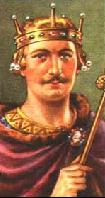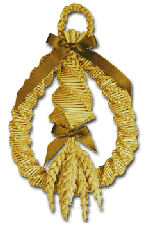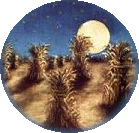


On Page 2 you will find food and drink recipes
![]()



On Page 2 you will find food
and drink recipes

Lammas is the medieval Christian name for the festival which takes place on August 1 - 2nd, and used to be considered the first day of Autumn. It takes it's name from the Saxon word for the Feast of Bread, Hlaf-mass, 'hlaf' meaning loaf and 'mass' meaning feast. This was the day on which loaves of bread were baked from the first grain harvest and laid on the church altars as offerings. It was a day representative of first fruits and early harvest.
This festival is also called 'Lugnasadh' (Loo-nah-sah), and is named after the Celtic God Lugh who also gave his name to the English capital city London, which was originally called Lugdunum. In Ireland, this was the feast to commemorate the funeral games of Lugh. However, Lugh's ritual death as grain God, which is necessary for the rebirth of the land to take place, occurs at the autumnal equinox. Lughnasadh infact celebrates the games which Lugh hosted to commemorate the death of his foster mother Taillte. That is why the Lughnasadh celebrations in Ireland are often called the 'Tailltean Games'. A common feature of the games were 'Tailltean marriages', which were rather informal and lasting only a year and a day or until next Lammas, at which time the couple would decide to continue the arrangement or stand back to back and walk away, thereby dissolving the marriage.
Until recent years, in Scotland, the first cut of the Harvest was made on Lammas Day, and was a ritual in itself. The entire family dressed in their finest clothing and would go into the fields. The head of the family would lay his bonnet (hat) on the ground and, facing the Sun, cut the first handful of corn with a sickle. He would then put the corn Sun-wise around his head three times while thanking the God of the Harvest for 'corn and bread, food and flocks, wool and clothing, health and strength, and peace and plenty'. This custom was called the 'Iolach Buana'.

In some areas, Lammas was a time of sacrifice. Sacrifices at Lammas were made to thank the Deities for the First Fruits and to guarantee an abundant Harvest. The victim was often the king, who was God Incarnate to his people. Sometimes a substitute king, a fool or "scapegoat", was sacrificed in the king's place.
| The last recorded sacrifice of a King of England occurred at Lammas, in the year 1100. King William II (Rufus the Red, or William Rufus) rejected the relatively new Christian beliefs, and openly declared himself Pagan. His death in a 'hunting accident' in the New Forest on August 2, 1100, is believed by many historians to have been a case of the traditional sacrifice being disguised for the sake of the Christian priests. Indeed, Walter Tyrrel who shot the fatal arrow, returned to his own country of Normandy unpursued after the 'accident' and lived there without hindrance. |  |
Some of the traditional customs still practised in Britian appear to include traces of ritual sacrifice of the divine victim. These will be discussed in more detail under 'Corn Dollies' and 'Morris Men'.

Corn Dollies date back to Pagan times. At harvest time, the correct procedures had to be followed in order to guarentee the success of the following year's harvest. The 'neck', which comes from the Norse word meaning 'sheaf', was the last remaining group of corn stalks, and it was thought to embody the spirit of the corn and no one wanted to deal the final cut and 'kill' it. So all the reapers would stand at a distance and throw their sickles in turn, until the neck was finally cut.
| In some areas, the last remaining sheaf of corn was tied to resemble an animal such as a mare or a hare. Elsewhere, the last sheaf was personified and was known either as a Corn Dolly, Kern Baby, or some other similar name. If the harvest was good, the last sheaf was dressed like a young girl, if the harvest was bad, it was dressed like an old woman. This would be stuck on a pole, held aloft, and taken back in a procession with the last load, to the barn where it presided over the harvest supper, and was kept till the next year either in the barn, the farmhouse, or in the church after the harvest festival. Often the last sheaf was ploughed back into the soil when ploughing started the next year. This would ensure that the corn's spirit would live on and provide a good harvest. |
|
Just as the corn spirit in animal form was sacrificed when the last sheaf was cut, it is thought that the personified sheaves may have represented sacrifices. It has been suggested that a living 'Corn Maiden' was sacrificed, or perhaps the sacrifice was the reaper who cut the last sheaf, in order to restore life to the corn spirit and thus ensure the continuance of the argricultural cycle.
A related tale is told of John Barleycorn: Three men meet to plot his death - they take a plough and bury him alive in a field, but he grows big and strong. The men cut him at the knee, tie him to their cart, beat him and strip the flesh from his bones. They finally grind him between two stones, but John Barleycorn (having been turned into beer), proves stronger than any of them.
| Often
intricate shapes were plaited from the last sheaf of
corn, and these have become a craft in themselves these
days. Corn Dollies are made from wheat, and have deep
pagan symbolic roots. The harvest knot for men has no
seeds, but the woman's knot has them intact, a symbol of
fertility. In Ireland the corn dolly was more often replaced with the corn cross. Such crosses were made with rushes or straw and were made in February for Bride's day, a Celtic saint. Harvest knots were also made as love tokens, to be given rather like lovespoons in Wales. |
 |
If you want to know how to make a Corn Dolly, CLICK HERE

Morris dancing, which is traditional to Great Britain, is an ancient tradition that has survived and evolved over the course of many centuries. It has been claimed to be a remnant of pre-Christian Celtic, or Druidic, fertility rites for soil and crops. Others believe that the dances seen today are derived from the French Moresque or the Spanish Morisca dances of the late 15th and early 16th Centuries. Certainly by the end of the 16th Century, Morris dancing had become established as a form of entertainment often accompanying the seasonal celebration of the coming of the Spring and Autumn harvests.
| Over the years, the dances have gone through many changes and several regional variations have developed, each one clearly different and each one contained within a particular area of England |
|
Cotswold Morris is danced in sets of six dancers arranged in two rows of three. For some dances, handkerchiefs are held in each hand, while for other dances short sticks are carried, and struck against each other or against those of a partner. Part of the costume includes bells, usually worn tied below the knees.
North-West Morris dancers wear colourful costumes, with clogs on their feet, and Yorkshire Longsword dances can be recognised by their circular formation and the swords used to link the dancers.
Along with the dancers, most Morris teams have a cast of other characters. These include the Fool, an animal or Hobbyhorse, an occasional visit by the Green Man, and musicians. The Fool is the prime link between the dancers and the onlookers and has long been associated with Morris Dances, sword dances and mummer's plays. Fools sometimes take the role of a court Jester with a Pigs bladder or sceptar (called a bauble) and a coxcomb or horned fool's cap (a possible direvitive of horned animal masks). But fools often simply dress in tattered or colorful cloths - a worn jacket or tattered hat, which is likely the origin of fool's names like motley or patch. Fools also sometimes wear a black face to disguise or add mystery to their character. The blackening of the face is usually done with soot, said to be a derivation from the purification of fire.
It is in the North of England, that remnants of ritual sacrifice appear in the dances. The significant moment in the sword dance is when the blades are woven together in a star shape and this is sometimes placed symbolically around the neck of the 'fool' of the group.

| HARVEST MOON The full moon nearest the autumnal equinox of the sun is known as the Harvest Moon. The moon rises at about the same time every night, and shines so brightly that farmers in northern latitudes are able to work in the fields until late at night taking in the fall harvest. |
 |
The moon following the Harvest Moon is the Hunter's Moon, much as the final storage of grain is followed by the first deer hunt.
LAMMAS FAIRS
Lammas Fairs, held annually throughout the British Isles, still exist today. At the Exeter Lammas Fair, a large, stuffed glove, decorated with flowers and ribbons, is fastened on top of a pole and carried about the fairgrounds. It is then placed on the roof of the Guild Hall to signify the opening of the fair. A gift of money for gloves (to servants) was also traditional at Lammastide. One theory is that the glove represents a unit of measure, indicating a fair rate of exchange. Another compares it to the Egyptian "open hand," representing friendship and fortune.
The name Lugh-Lamhfhada means "Lugh of the Long Hand," and Llew-Law Gyffes, another name for the same God (Welsh), means "The Lion with the Steady Hand." It is probable that the glove might simply be a symbol for Lugh, with whom the festival has often been associated (as in Lughnasadh).